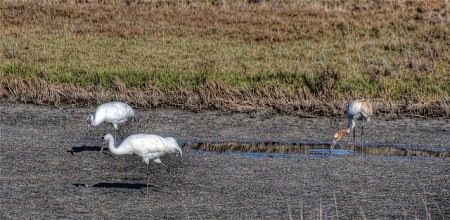The ups and downs of wild animal success stories

Whooping Cranes are among the rebounding threatened species. This family group is at its nesting ground in Wood Buffalo National Park in northeastern Alberta. Photo: Angi English, Creative Commons, some rights reserved
There’s a lot of bleak tidings for far too many creatures these days, including (but not limited to) bats, monarch butterflies and bees. So it’s a relief when happier trends come along.
Here’s an example from Canadian Geographic‘s December issue: “Species on the rebound – The remarkable resurgence of seven Canadian Critters” As the intro puts it “From pintsize Prairie predators to Pacific giants, these seven Canadian species have rallied from the very edge of extinction.”
Those seven are: whooping crane, humpback whale, Eastern wild turkey, Swift fox, sea otter, wood bison, and peregrine falcon. The article added a “too close to call” category for three species that may be headed toward stability: black-footed ferret, Newfoundland marten and Kirtland’s warbler.
On a similar note, here’s a BBC comeback article highlighting gains in populations and health of key wild animals in Europe, including predators and scavengers like bears, wolves, lynx, eagles and vultures:
Frans Schepers, the organisation’s director [ed. note: of Rewilding Europe] said: “People have this general picture of Europe that we’ve lost all our nature and our wildlife.
“And I think what the rest of the world can learn from this is that conservation actually works. If we have the resources, a proper strategy, if we use our efforts, it actually works.”
Obviously, revitalizing animal populations – especially predators – is often controversial. Scott Sayare offers a poignant view of how that can play out in this September 2013 article for the New York Times: “As Wolves Return to the French Alps, a Way of Life is Threatened”:
But to the exasperation of this region’s shepherds, who for generations have scaled these hills with the seasons, the species’ success has been due in no small part to the ample, easy pickings. Wolves have been slaughtering vast numbers of sheep here — at least 20,000 in just the past five years, according to an official count. The government has spent tens of millions of euros in efforts to stanch the attacks, but to little avail, and shepherds increasingly call the wolf an existential threat.
“They’re killing shepherding as I know it,” said Bernard Bruno, 47, who has lost at least a thousand sheep in recent years. The wolf’s return may symbolize environmental progress to some, said Mr. Bruno, a stout, blue-eyed man who has spent 25 summers alone here with his flock and a walking stick. But it has also imperiled “one of the last natural, ecological kinds of livestock farming,” he said.
Of course, wild animals were here first and have every right to healthy continued existence. Similarly, a balanced ecosystem supports all life on earth, including we humans. But challenges arise when it comes to balancing conflicting interests. Ottawa residents know all about the wild turkeys of Barrhaven. (They may sound harmless, but check out the story-comment shared by Michael Greer.)
Are you in favor of putting the wild back in wilderness, or are cougars, wolf packs and such more than you want to deal with?
Tags: canada, Canadian Geographic Magazine, endangered species, environment, French shepherds, science, wolves








What makes the plight of Wildlife even bleaker is that we haven’t even begun to access their response to Climate Change, which is occurring much too quickly for them to adapt.
More on Wildlife in our area: http://rochesterenvironment.com/animals.htm
Sheep! Bah humbug! One of the must environmentally destructive animals on the planet. They played a large part in turning the land of milk and honey into a desert.
Here in this country, we would have been better off managing the herds of buffalo instead of killing them off to raise cattle.
I think we do need to celebrate the success stories both in species and in ecosystems. Those stories do exist and can guide us on what works. From an environmental/habitat stand point we are better off today in the US and Canada today in many respects than we were at the beginning of the 20th century.
Protections do work as these stories show. It’s easy to get discouraged but many of these populations are more adaptable than we give them credit for and humans can change also.
As far as releasing predators into their old ranges yes I would certainly favor that as long as it was viable. Sometimes things are not viable ecologically. For example I do not think it is viable to release wolves in the Adirondacks, there simply is not the food sources that they need, they would end up getting shot or removed as they caused problems in populated areas. I think mountain lions would stand a chance.
How about wood bison?
Another story to watch along with this is the cutback in the current ag bill for the CRP programs which are very successful.
I read how there is a plan underway to kill 3500 barred owls to make way for the spotted owl in Oregon at the cost of $1000 per owl. Harry Potter should object.
It’s actually 3600 barred owls, which brings the cost down to the bargain price of just $972 per owl killed. There ought to be a better way… At least they’re making use of the slain owls for research. http://www.registerguard.com/rg/news/local/30900942-75/barred-owls-owl-spotted-california.html.csp